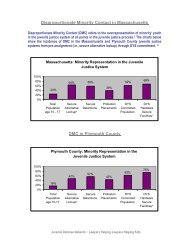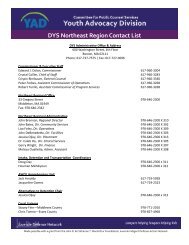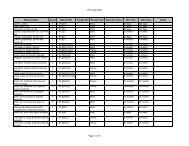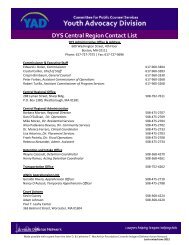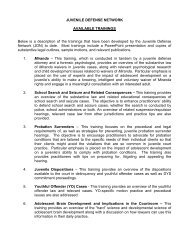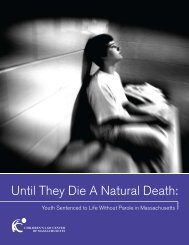States rethink 'adult time for adult crime' - the Youth Advocacy Division
States rethink 'adult time for adult crime' - the Youth Advocacy Division
States rethink 'adult time for adult crime' - the Youth Advocacy Division
Create successful ePaper yourself
Turn your PDF publications into a flip-book with our unique Google optimized e-Paper software.
Teen Brains on Trial: Science News Online, May 8, 2004<br />
The results in <strong>the</strong>se small experiments remain preliminary. Even if <strong>the</strong> findings<br />
hold up, it's not clear whe<strong>the</strong>r young teens' difficulties in discerning fearful<br />
expressions stem from incomplete brain development or reflect unique duties<br />
assumed by <strong>the</strong> frontal lobes during adolescence. What's more, teenagers<br />
and <strong>adult</strong>s have yet to be similarly tested with faces displaying emotions o<strong>the</strong>r<br />
than fear.<br />
Baird's ongoing research suggests that <strong>the</strong> teen frontal brain indeed responds<br />
to spontaneous emotional expressions on <strong>the</strong> faces of friends and family<br />
members. "Kids say that <strong>the</strong> posed expressions we show <strong>the</strong>m look kind of<br />
weird," Baird says.<br />
O<strong>the</strong>r evidence suggests that mental efficiency in solving emotion-related<br />
tasks—indicated by <strong>the</strong> <strong>time</strong> taken to answer <strong>the</strong>m correctly—suffers with <strong>the</strong><br />
arrival of puberty, when gray matter volume in <strong>the</strong> frontal lobes hits its peak,<br />
according to Robert F. McGivern of San Diego State University.<br />
Response speed improves gradually after puberty and stabilizes at around<br />
age 15, a <strong>time</strong> when substantial neural pruning and myelin expansion in <strong>the</strong><br />
frontal lobes have already occurred, McGivern and his colleagues reported in<br />
2002.<br />
The researchers had studied 246 youngsters, ages 10 to 17, and 49 young<br />
<strong>adult</strong>s, ages 18 to 22. In one trial, participants saw a series of faces with<br />
various posed expressions—happy, angry, sad, or neutral—after being told to<br />
answer "yes" if <strong>the</strong>y saw a happy face and "no" <strong>for</strong> all o<strong>the</strong>rs. Each face<br />
appeared <strong>for</strong> only a fraction of a second.<br />
The participants <strong>the</strong>n completed three additional trials in which <strong>the</strong>y were told<br />
to answer "yes" <strong>for</strong> angry, sad, or neutral faces.<br />
Girls responded to <strong>the</strong>se problems more slowly at ages 11 and 12 than <strong>the</strong>y<br />
did at age 10, while boys took longer to answer at age 12 than <strong>the</strong>y did at<br />
ages 11 or 10. These declines closely corresponded to puberty's onset in<br />
each sex, McGivern says.<br />
Cycles of brain growth in boys and girls, which are <strong>time</strong>d differently during<br />
adolescence, some<strong>time</strong>s aid and some<strong>time</strong>s hinder mental dexterity in<br />
detecting various emotions, in McGivern's view.<br />
Risky business<br />
Scientists are also beginning to probe <strong>the</strong> brain's contributions to teenagers'<br />
penchant <strong>for</strong> risky and impulsive behaviors, such as experimenting with illicit<br />
drugs. Preliminary data indicate that, while playing a simple game to win<br />
monetary prizes, adolescents exhibit weaker activity than young <strong>adult</strong>s do in a<br />
brain region that scientists consider to be crucial <strong>for</strong> motivating ef<strong>for</strong>ts to<br />
obtain rewards or attain goals.<br />
A team led by James M. Bjork of <strong>the</strong> National Institute on Alcohol Abuse and<br />
Alcoholism in Be<strong>the</strong>sda, Md., used fMRI to scan <strong>the</strong> brains of 24 people, half<br />
between ages 12 and 17 and <strong>the</strong> rest between 22 and 28. Brain<br />
measurements were taken as <strong>the</strong> participants decided whe<strong>the</strong>r to press a<br />
button upon seeing various visual cues, only one of which <strong>the</strong>y had been told<br />
to respond to. On some trials, correct answers yielded prizes of 20 cents, 1<br />
dollar, or 5 dollars. On o<strong>the</strong>rs, correct answers prevented losses of those<br />
amounts.<br />
file:///L|/JDN/Brain%20Resources/Brain%20Development/Mailing%20Packet/10.%20Teen%20Brains%20on%20Trial.htm (4 of 9)8/16/2006 4:45:04 PM





